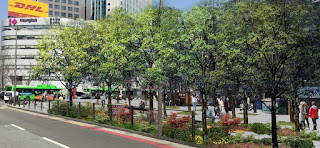 |
| Sejong-daero towards Gwanghwamun, viewed from the Deoksugung-Seoul Plaza crossing |
The main changes (drawn here by Kim Yeong-eun for Yonhap News Agency**), expected by the end of the year, consist in reducing the number of traffic lanes (from 12 to 7-9; at least that's consistent with the new bottlenecks conceived further North around the avenue), and improve the pedestrian experience, particularly around Deoksugung and Sungnyemun / Namdaemun Market:
A lot of trees shall be added to widened sidewalks, with some species diversity which is really positive. Even if naming this "Sejong Forest" (세종숲) sounds a bit over the top (at least the Gyeongui Line Forest Park was more honest with its "숲길", which could be translated into 'Forest walk / way / street').
 |
| A plaza and a tree trail shall improve the barren entrance to Namdaemun Market from Sungnyemun |
I'm looking forward to the new bicycle lane all along the 1.5km stretch (I criticized the city for not adding some on day one when they renovated the Northern section of Sejongdaero for Gwanghwamun Square), and the eased pedestrian circulation around Sungnyemun, which even after the changes will remain basically a peninsula in a sea of cars:
 |
| A better experience for pedestrians and cyclists, but still car centric |
Moving back to Deoksugung and Jeong-dong, this close up of Daehanmun shows that, beyond the extension of the plaza and sidewalks, Deoksugung-gil is likely to become car-free, at least partly (and I presume at least on weekends and holidays, like Insadong-gil):
Overall, nothing revolutionary, but significant improvements for Sejong-daero. Needless to say, Mayor Park Won-soon would love to see part of downtown's growing - at least B.C. / Before Coronavirus - tourist traffic walk closer to his pet project Seoullo 7017. before the 2022 presidential elections.
Again, I can't stress enough the importance of Sejong-daero, the spine of downtown Seoul, at its original core. We're talking urban stem cells here. ICYMI here's the short video I made to explain the dynamic map of Seoul intra muros a.k.a. Sadeaemun (fortress walls, main gates, mountains and streams, key landmarks, vertical and horizontal axes...):
Seoul Village 2020
Welcome to our Korean Errlines! Follow Seoul Village on Facebook and Twitter, follow me on Instagram.
* "서울 중구, 세종대로 등 145개 점포 간판 정비" (Yonhap News 20200420).
** "세종대로 1.5km 구간 보행로 대폭 확장…차로 12개→9개 축소" (Yonhap News 20020426)









No comments:
Post a Comment
Thank you for your comments and remarks. Also for your patience (comments are moderated and are not published right away - only way to curb the spam, sorry). S.